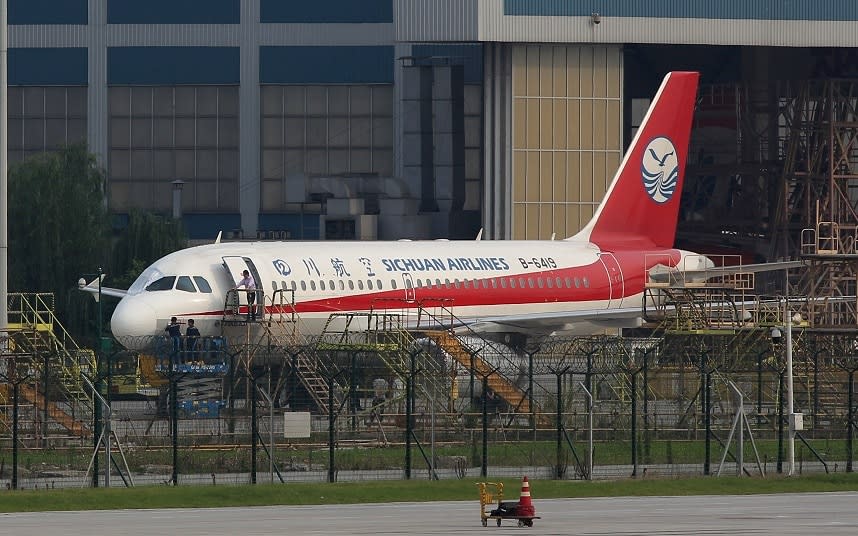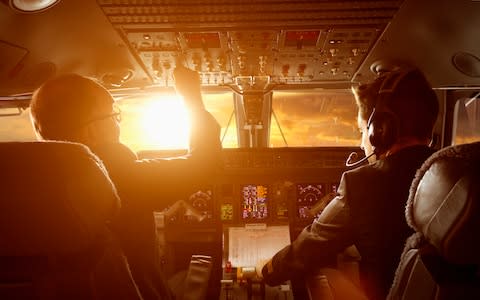Pilot 'sucked halfway out' of plane after windscreen broke at 32,000 feet – how often does this happen?

A Chinese passenger jet was forced to make an emergency landing after the co-pilot was ‘sucked halfway out’ of the cockpit after the windscreen shattered in mid-air.
Speaking to the Chengdu Economic Daily, Captain Liu Chuanjian said that the aircraft had just reached an altitude of 32,000 feet when the windscreen smashed.

“There was no warning sign. Suddenly the windscreen just cracked and made a loud bang. The next thing I know my co-pilot had been sucked halfway out of the window,” he is reported to have said.
“Everything in the cockpit was floating in the air. Most of the equipment malfunctioned... and I couldn’t hear the radio. The plane was shaking so hard I could not read the gauges.”
Because he was wearing a seatbelt, the co-pilot was pulled back into the cockpit - sustaining only scratches to his face and a sprained wrist. One other member of cabin crew was injured in the descent, but none of the 119 passengers were hurt.
The temperature of the cockpit is reported to have dropped to minus 40 degree Celsius, forcing the plane to descend rapidly for five to six seconds before the pilot grabbed an oxygen mask and managed to manually regain control.
The safest mode of transport: Deaths per billion journeys
The Sichuan Airlines flight departed from the central Chinese municipality of Chongqing at 6.30am on Monday morning, due to arrive in Lhasa, Tibet at 9.30am. It made the emergency landing at Shuangliu International Airport in Chengdu, 250 miles west of Chongqing, half an hour after take-off.
Sichuan Airlines is a regional airline based in Chengdu; it mainly operates domestic flights, but also has international routes to Canada, Japan and the Czech Republic.
The incident comes just weeks after a woman died on a Southwest Airlines flight from New York to Dallas when part of the engine broke off, shattered a window and nearly sucked her out.
Mrs Riordan, a banking executive, was pulled back into the aircraft by other passengers, who attempted to resuscitate her, but she later died of her injuries.
With two high-profile instances of cracked windows on planes in a month, how does this happen, how frequently do windscreens shatter, and what is the protocol for pilots in these emergency incidents?
Why do cockpit windscreens crack?
Cockpit windscreens (sometimes referred to as windshields) are typically comprised of several layers, designed to deal with air pressure of up to 500 knots and to avoid shattering when striking a bird. However, they are not indestructible.
A common cause of windscreens shattering is severe hailstorms. In August 2015, a Delta Airlines flight was forced to make an emergency landing in Colorado after its windscreen and nose cone were badly damaged by hail. Despite the damage, the pilots were able to land the airline safely. A similar incident occurred on an Atlasglobal flight from Istanbul to north Cyprus last year.
Graphic: Cabin pressure
Another cause could be a malfunctioning component within the cockpit. In June 2010, pilots in an American Airlines Boeing 757 were showered with glass after a loose screw in the cockpit window heater caused the inside ply of the windscreen to shatter.
The windscreen may also break if it has not been heated correctly. Many aircraft have electronically heated windscrens to soften the acrylic layer of the window in case of a bird strike. However, if the screen is heated unevenly or short-circuits, it may crack or shatter due to the difference of pressure inside and outside the cabin. Many windscreens will undergo five to six thousand flights, making them more vulnerable to cracks.
How often do cockpit windscreens shatter?
More often than you might think.
According to Oliver McGee, professor of engineering and former Deputy Assistant Secretary in the US Department of Transportation, there is a cracked or shattered cockpit windscreen incident “every week or two”.
However, McGee says that for every shattered cockpit windscreen that is reported, there is likely to be one that is not. He writes: “Airlines typically do not like to widely disclose such safety breaches for obvious reasons of natural passenger and crew uneasiness, apprehension, and discomfort.”
Usually it is the outermost pane that cracks, and total windscreen failures like the one in China this week are extremely rare.
How to survive a plane crash
Writing on a blog about cockpit windscreen breaches, one pilot said: “Thus far, I've had four cracked or shattered windshields during my career. The first was in a King Air 200 during climb out (we returned to the departure airport and swapped to another King Air 200), the next two were in 727s, both in cruise and both apparently due to faulty temperature controllers and the most recent in a 737, just prior to the top of descent and again due to a faulty temperature controller.
“In all four occasions, there was no loss of cabin pressurization and normal landings were completed,” he added.
What is the protocol for pilots when a windscreen shatters?
Speaking to Telegraph Travel, Richard Taylor of the Civil Aviation Authority said: “There are no set protocols for dealing with an incident. Every airline develops its own Standard Operating Procedures (SOPs) which its pilots will follow in a given situation. These SOPs are unique to an airline’s operation and take into account the type of aircraft and routes flown.”
Looking at instances of shattered windscreens in the past, standard protocol for a shattered windscreen is for the pilots to go on oxygen, contact air traffic control and divert the flight for an emergency landing at the nearest airport. Immediately after a partial windscreen breakage, they may enter a descent to below 10,000 feet to avoid catastrophic decompression.

